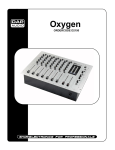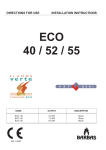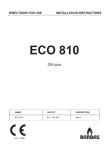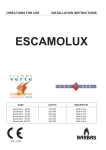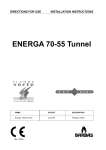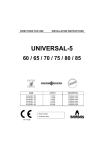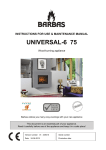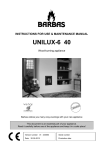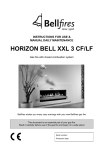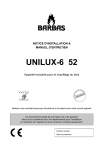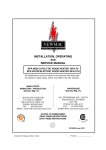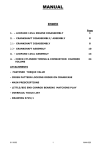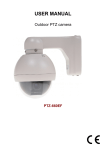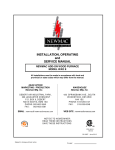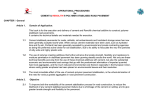Download ECO 60 / 70 / 90 / 100
Transcript
DIRECTIONS FOR USE INSTALLATION INSTRUCTIONS ECO 60 / 70 / 90 / 100 NAME ECO 60 ECO 70 ECO 90 ECO 100 EN -13240 OUTPUT DESCRIPTION 9.0 kW 10.0 kW 10.0 kW 10.0 kW Stove Stove Stove Stove ECO 60 / 70 / 90 / 100 ECO 60 ECO 70 ECO 90 ECO 100 Floor plate is optional ! 3 ECO 60 / 70 / 90 / 100 4 ECO 60 / 70 / 90 / 100 INTERFOCOS B.V. 11 EN 13240:2010 Stove fired by solid fuels for space heating in residential buildings. - Name: Barbas - Model: ECO 60 - Types of fuel: Wood logs and briquettes (pressed wood blocks without binding agent) Fire safety: (risk to adjacent elements/objects) - Indicated safety distances to flammable material - Rear - Side Pass 100 mm 100 mm Emission combustion products + Pass + carbon monoxide (CO) emission: 0.10% Escape of hazardous substances Not determined Surface temperature Pass Electrical safety Pass Cleanability Pass Flue gas temperature 312°C Mechanical resistance Pass Capacity (= thermal output) and energy efficiency, such as: - efficiency Pass (75%) - flue draught 12 Pa - interval replenishing wood at: -nominal heating capacity (= nominal heat output) 0.75 h - space heating capacity (= space heating output) 9.0 kW Durability Pass 5 ECO 60 / 70 / 90 / 100 INTERFOCOS B.V. 11 EN 13240:2010 Stove fired by solid fuels for space heating in residential buildings. - Name: Barbas - Model: ECO 70 - Types of fuel: Wood logs and briquettes (pressed wood blocks without binding agent) Fire safety: (risk to adjacent elements/objects) - Indicated safety distances to flammable material - Rear - Side Pass 100 mm 800 mm Emission combustion products + Pass + carbon monoxide (CO) emission: 0.04% Escape of hazardous substances Not determined Surface temperature Pass Electrical safety Pass Cleanability Pass Flue gas temperature 305°C Mechanical resistance Pass Capacity (= thermal output) and energy efficiency, such as: - efficiency Pass (77%) - flue draught 12 Pa - interval replenishing wood at: 6 -nominal heating capacity (= nominal heat output) 0.75 h - space heating capacity (= space heating output) 10.0 kW Durability Pass ECO 60 / 70 / 90 / 100 INTERFOCOS B.V. 11 EN 13240:2010 Stove fired by solid fuels for space heating in residential buildings. - Name: Barbas - Model: ECO 90 - Types of fuel: Wood logs and briquettes (pressed wood blocks without binding agent) Fire safety: (risk to adjacent elements/objects) - Indicated safety distances to flammable material - Rear - Side Pass 100 mm 100 mm Emission combustion products + Pass + carbon monoxide (CO) emission: 0.06% Escape of hazardous substances Not determined Surface temperature Pass Electrical safety Pass Cleanability Pass Flue gas temperature 304°C Mechanical resistance Pass Capacity (= thermal output) and energy efficiency, such as: - efficiency Pass (80%) - flue draught 12 Pa - interval replenishing wood at: -nominal heating capacity (= nominal heat output) 0.75 h - space heating capacity (= space heating output) 10.0 kW Durability Pass 7 ECO 60 / 70 / 90 / 100 INTERFOCOS B.V. 11 EN 13240:2010 Stove fired by solid fuels for space heating in residential buildings. - Name: Barbas - Model: ECO 100 - Types of fuel: Wood logs and briquettes (pressed wood blocks without binding agent) Fire safety: (risk to adjacent elements/objects) - Indicated safety distances to flammable material - Rear - Side Pass 100 mm 100 mm Emission combustion products + Pass + carbon monoxide (CO) emission: 0.06% Escape of hazardous substances Not determined Surface temperature Pass Electrical safety Pass Cleanability Pass Flue gas temperature 304°C Mechanical resistance Pass Capacity (= thermal output) and energy efficiency, such as: - efficiency Pass (80%) - flue draught 12 Pa - interval replenishing wood at: 8 -nominal heating capacity (= nominal heat output) 0.75 h - space heating capacity (= space heating output) 10.0 kW Durability Pass ECO 60 / 70 / 90 / 100 TABLE OF CONTENTS Page 1. Introduction 1.1 Preface...................................................................................11 1.2 Safety and installation instructions.........................................11 2. Location 2.1 Included..................................................................................14 2.2Accessories............................................................................14 2.3 Preparation for positioning.....................................................16 3. Installation instructions 3.1 Fitting instructions.................................................................. 20 3.2 Chimney.................................................................................20 3.3 Aeration / ventilation...............................................................22 3.4 Fitting the stove......................................................................23 4. Operation of the stove....................................................................39 5. Stoking up for the first time.............................................................42 6. Use 6.1Ventilation..............................................................................43 6.2 Getting the fire going.............................................................43 6.3 While stoking..........................................................................44 6.4 Heating economically.............................................................47 6.5 Cleaning the window..............................................................47 7. General hints 7.1 Tips........................................................................................ 48 7.2 Output....................................................................................49 8. Fuels 8.1 Wood...................................................................................... 51 9. Amount of fuel 9.1 Amount of fuel........................................................................ 52 9.2 Heat radiation......................................................................... 54 10. Regular maintenance...................................................................... 55 11. Replacement parts......................................................................... 56 12.Dimensions....................................................................................72 13. Technical data...............................................................................76 14. Frequently asked questions........................................................... 78 9 ECO 60 / 70 / 90 / 100 10 ECO 60 / 70 / 90 / 100 1. INTRODUCTION 1.1. PREFACE We would like to congratulate you on your purchase of this modern BARBAS stove. This quality product will give you years of heating pleasure as you enjoy the play of the flames and the cosy glow of the fire. This manual contains directions for both positioning the appliance and for its environmentally-friendly use. It also contains technical data for the appliance, parts information and directions in the event of problems. Study this manual carefully before using the stove. We recommend you keep this manual in a safe place for reference purposes. 1.2. SAFETY AND INSTALLATION INSTRUCTIONS Safety • Do not place flammable objects within 80 cm of the appliance. Pay special attention to furnishings and ornaments around the stove. • To ensure safe operation, the following minimum distances must be maintained between the appliance and any existing side or rear wall (temperature ≤ 80 °C). ECO 70 : in respect of side wall : Distance ≥ 80 cm ECO 70 : in respect of rear wall : Distance ≥ 10 cm ECO 60/90/100 : in respect of side wall : Distance ≥ 10 cm ECO 60/90/100 : in respect of rear wall : Distance ≥ 10 cm • If the floor is flammable, a nonflammable floor plate should be used under the appliance. Use the floor plate as mentioned in chapter 2.2. • When you use your stove, the exterior will become hot. Always wear the glove or use the accessories supplied when filling etc. Protect yourself and others (especially children!) from burns. Do not leave children unattended when the stove is burning. • Watch your clothing. Synthetic clothing in particular can easily catch fire and burn intensely. 11 ECO 60 / 70 / 90 / 100 • Do not approach the appliance with flammable materials or liquids. Any work with solvents, adhesives etc. in the space heated by the stove can be very dangerous. • Make sure you know what state your chimney is in. Cracks in the chimney may not only lead to damp, staining of walls and leaking of smoke, they can also impair the carrying off of smoke. Make sure you get proper advice from your Barbas dealer or other specialist company. • • Avoid chimney fires! Have your chimney swept at least once per year - more often if you use your stove a lot. Prevent excessive deposits of soot inside the chimney by not burning freshly-cut wood. Instead, burn clean, dry chopped wood. Do not use your stove as a barbecue. This can cause (flammable) fat deposits to be left in the chimney and hastens the chimney becoming clogged. Prevent your chimney being soiled from above (birds’ nests etc.) by fitting a suitable cap to the chimney pot. • Follow the instructions issued by your local fire brigade. The stove can be taken in operation if national and local regulations are satisfied. The required constructive adaptations should be satisfied as well. Installation Instructions • Wood and wood bricks can be burned in the stove. Coals can’t be burned in the stove. • Never use the stove to burn rubbish. • Read all instructions/stickers, on and around, the appliance. • Carefully read the user manual before using your appliance for the first time. When you first fire up your appliance, there are a number of extra points you should take into account. See section 5. • Never use liquid fuels, such as petrol, lighter fluid etc. Use of these could cause dangerous situations and damage your appliance. 12 ECO 60 / 70 / 90 / 100 • In transit, some parts of the appliance may have moved from their original place. Check that the door opens and closes, the brake plate is fitted correctly to the brackets at the top of the fire, the side panels are fixed to the walls and the panels on the bottom have not moved. Check whether the grate is lying correctly and there are no foreign objects in the ashtray. • Avoid over-loading (white burning glow), caused, for example, by lengthy burning with primary air (combustion air supply slider all the way to “ + ”) or by burning too much wood in one go. The stove can then become overheated. This may damage the grate and the metal flue gas flap (ECO 60). • Consult the current local building regulations before starting the assembly. 13 ECO 60 / 70 / 90 / 100 2. LOCATION 2.1. INCLUDED Set - documentation - In the appliance Attributes - - - - ECO 100 Soapstone - Warranty Manual Glove (Heat resistant up to max. 95°C) Operating hook / Poker Universal flue gas exhaust set 2x Top/bottom plate (with through-feed hole), Soapstone 2x Side panel (L/R), Soapstone N.B. If any part is missing, please contact your dealer. 2.2. ACCESSORIES The following accessories can be supplied by your dealer: Color Accessorie Part no Anthracite Floor plate E ECO 60/70/90/100 327633 Collar adaptor Ø125 mm (for combustion air supply) 309730 Hose clamp Ø125 mm (for combustion air supply) 304040 Cover plate, for top appliance Ø150 mm Steel (for ECO 60 Rear connection) 327301 Cover plate, for rear appliance Ø150 mm Steel (for ECO 60 Top connection) 329534 14 - ECO 60 / 70 / 90 / 100 Thick-walled (2 mm) steel chimney system Ø150 mm: Description Part no Color Anthracite Gray 310087 Duct 1000 mm 310094 Duct 500 mm Duct 1000 mm + valve 310088 310095 310180 310186 310093 Elbow 90° 310100 Elbow 45° 310091 310098 310090 Elbow 30° 310097 Support sleeve, double-walled302226 - Rosette 310181 310187 15 ECO 60 / 70 / 90 / 100 2.3. PREPARATION FOR POSITIONING Check all functions of the stove before fitting. • Check the opening and closing operation of the door. Turn the handle all the way down: Door is locked. This handle position should be set when the appliance is not in use. • Handle forwards: The door releases from its lock and can be opened forwards. 16 ECO 60 / 70 / 90 / 100 • Check the operation and setting of the flue gas flap (ECO 60). Flue gas flap pin Flue gas flap Door open Door closed Pin comes forwards Pin is pressed in by the door Flue gas flap open Flue gas flap closed • If necessary, the flue gas flap pin can be adjusted (ECO 60). 17 ECO 60 / 70 / 90 / 100 • Check the operation of the slider for controlling the combustion air. • Check whether the ashtray is completely empty. 18 ECO 60 / 70 / 90 / 100 • Report any defects immediately to your dealer. • Remove enclosed documents and components from the stove. Have the suitability of the area in which the stove is to be placed (and the chimney) approved by a specialist. The stove must have its own chimney, constructed in compliance with current legislation. 19 ECO 60 / 70 / 90 / 100 3. INSTALLATION INSTRUCTIONS 3.1. FITTING INSTRUCTIONS When fitting the stove, local and/or national regulations relating to fire safety must be followed. In case of doubt, consult the fire safety department of the local fire brigade, particularly if the stove is to be fitted in a home with walls and/or floors containing flammable material. Position the appliance sufficiently far away from the wall behind it, according to the data from chapter 1.2. If the walls are not fire-proof, the distance should be such that the wall in question cannot become hotter than 80°C, even when the stove is stoked up to high temperatures. In case of doubt, insert a fire-proof protection shield. The floor on which the appliance is placed must have sufficient bearing power. The connection of several appliances to a single flue/chimney is not allowed. 3.2.CHIMNEY Be sure that existing chimneys are completely air-tight and in good condition. In terms of dimensions, the chimney must have a diameter of at least 150 mm for the entire length (including the chimney pot). Ensure that the chimney is fitted with an appropriate cap to avoid rain and dirt getting in (as well as bird’s nests). The draught flowing through the chimney determines how well your stove will burn (recommended draught 0.15 mbar: = 15 Pa). In the event of problems, a solution may be a different chimney cap, if necessary one with a chimney fan. Contact a specialist if you have any doubts about any of the above points. If your chimney is unsuitable, or if your home does not have a chimney, we recommend the use of double-walled stainless steel chimney sections. Chimneys must comply with the prevailing building regulations. Make sure the building is carried out by a specialist. When purchasing such chimneys, be sure to check if a casing is required. 20 ECO 60 / 70 / 90 / 100 Important: • Chimneys must be free-standing, i.e. they must not rest on the appliance itself. • Any pipe connections that are not insulated must also be fully insulated. • Flammable material must be kept clear (outside the casing/insulation zone) of all through-feeds in the floor or wall (remember the roof decking). • The chimney opening must be at least 5 metres above the top of the door opening of your appliance. • The chimney must protrude at least 40 cm above the apex of a sloping roof and at least 1 metre above a flat roof. In short, the chimney must always end in an area with a negative air pressure. Contact your local chimney sweep for the exact dimensions of the chimney opening. Between the stove and chimney, use thick-walled smoke piping (Steel, ≥2 mm). See Chapter 2.2. The first pipe connected to the appliance must have a diameter of 150 mm (int.) at both ends. This will prevent any condensation from the chimney running over the external end of the pipe. Connect the pipes to the existing chimney (ceiling) using a sliding sleeve (niche pipe). Check all connections for air-tightness. If there is too much draught running through your chimney (e.g. if the chimney is long and straight in a tall building), it may be possible to insert a chimney valve in the pipe near the appliance. Before doing this, be sure to obtain sound advice from a specialist. Do not make any horizontal connections. Deposits and soot will accumulate here (unless it is a short horizontal connection directly behind the stove). Avoid bends at all costs. The maximum deviation from the perpendicular is 45°. The chimney calculation, as in Germany, is made according to DIN 4705 parts 1 and 2. 21 ECO 60 / 70 / 90 / 100 The mass flow and exhaust temperature of the stove The mass flow and exhaust temperature of the stove are shown in chapter 13; Technical Data. These values are important to consider when assessing the dimensions of the flue to which the stove is to be connected. Cleaning the chimney/flue Make sure your chimney/flue is cleaned at least once a year by a recognized chimney sweep. If the chimney has a chimney valve, the free opening in the chimney valve flap must measure at least 12% of the surface. 3.3. AERATION / VENTILATION A stove generates: - heating air - combustion air Heating air (convection air) is devoted to the convection of heat from the appliance to the room. The source of heat is in the room and stays there. Combustion air is needed to keep the combustion going by drawing in air from the room, or directly from outside, due to the natural draught of the chimney. • Combustion air from the living-room: The air inlet opening; Ø125 mm, is found at the rear of the appliance. When using the appliance, please ensure there is a sufficient supply of fresh air: minimum 150 cm2 (Ø125 mm) opening in the room where the fire is placed. Make sure that the ventilation supply is open; this is particularly important with today’s airtight dwellings. If the dwelling has mechanical ventilation that creates under pressure in the room where the appliance is located, it is necessary to fit a flue gas fan. The type of flue gas fan is dependent on the capacity of the mechanical ventilation system. Always consult your fitter about this. In dwellings with an operating extractor hood, this should be turned to the lowest setting or turned off altogether. If the extractor hood remains in use, additional ventilation must be provided in compensation. 22 ECO 60 / 70 / 90 / 100 This will not only avoid poor combustion, but will also prevent flue gases being sucked from the appliance into the room. Should creating an extra ventilation opening prove insufficient, it is then necessary to fit a flue gas fan. • Combustion air directly from outside: The appliance now has a completely closed combustion system, which allows it to operate independently of the surrounding air in the room where the appliance is located. 3.4. FITTING THE STOVE 3.4.1. Connecting the smoke outlet ECO 60: The appliance can make use of either a top or rear connection Ø150 mm (Ø150 mm external) for the flue (chimney). The appliance is supplied with the flue gas exhaust flue connection and cover plate that was stated with the order. Assembling of the smoke outlet ECO 60 top connection: - Install the cast-iron flue gas exhaust flue connection ring to the top of the appliance. Attention ! Ensure that the sealing cord fits properly all round. 23 ECO 60 / 70 / 90 / 100 - Assemble the sealing plate to the rear of the combustion chamber of the appliance. Attention ! Ensure that the sealing cord fits properly all round. - Assemble the cover plate to the rear of the appliance. 24 ECO 60 / 70 / 90 / 100 Assembling of the smoke outlet ECO 60 rear connection: - Install the cast-iron flue gas exhaust flue connection ring to the rear of the appliance. Attention ! Ensure that the sealing cord fits properly all round. - Assemble the sealing plate to the top of the combustion chamber of the appliance. Attention ! Ensure that the sealing cord fits properly all round. 25 ECO 60 / 70 / 90 / 100 - Place the cover plate on top of the appliance. ECO 70/90/100: The appliance has only a top connection Ø150 mm (Ø150 mm external) for the flue (chimney). See ECO 60 for the sequence for installing the flue gas exhaust. General: The smoke outlet connection is intended for steel stovepipes, double/singleskinned stainless steel (insulated) flues or double/single-skinned flexible stainless steel flues. Situate the appliance in such a way that the flue gas outlet is precisely in line under the chimney connection (niche pipe) in the ceiling (top connection) or with the chimney connection (niche pipe) in the wall (rear connection). 3.4.2. Exchanging smoke gas exhaust top and rear connection ECO 60 • 26 In order to be able to exchange the smoke outlet top- and rear connection, first remove the flue gas flap and the brake plate first. See chapter 11 for the disassembly sequence of the flue gas flap and the brake plate: “Sequence for replacing the interior of the appliance ECO 60”. ECO 60 / 70 / 90 / 100 - Remove the cast-iron flue gas exhaust flue connection ring on the top of the appliance. • Remove the cover plate at the rear of the appliance. 27 ECO 60 / 70 / 90 / 100 • Remove the sealing plate at the rear of the combustion chamber of the appliance. • Install the cast-iron flue gas exhaust flue connection ring to the rear of the appliance. Attention ! Ensure that the sealing cord fits properly all round. 28 ECO 60 / 70 / 90 / 100 • Assemble the sealing plate to the top of the combustion chamber of the appliance. Attention ! Ensure that the sealing cord fits properly all round. • Place the steel cover plate on top of the appliance. 29 ECO 60 / 70 / 90 / 100 3.4.3 Positioning the appliance • Level the appliance. ECO 60 / 70 / 90 All steel parts are factory assembled. ECO 100 (Soapstone) The soapstone side panels (L+R) and 2x top/bottom plate are supplied separately. Process the soapstone with dry, clean hands. You can remove any stains on the soapstone with a dry scouring sponge. Choose which soapstone top/bottom plate will be placed in view on the top of the appliance. Soapstone is a natural product. That is why differences in colour and structure are normal. • 30 Place a soapstone top/bottom • Place the supplied brass spread plate, with the 4 small holes anchors (4x) in the holes and screw upwards, on the location where the threaded pins into them. the appliance will stand. ECO 60 / 70 / 90 / 100 • Place the appliance carefully on the soapstone bottomplate. Keep 4 cm free to both left and right. Align the appliance with the front soapstone edge. • Also check whether the appliance with the soapstone bottomplate is level. Pack the bottomplate underneath with metal plates as required. 31 ECO 60 / 70 / 90 / 100 • Place the supplied brass spread anchors (totally: 4x) in the top of the soapstone side panels and screw the threaded pins into them. 32 ECO 60 / 70 / 90 / 100 • Place the side panels carefully over the two metal pins in the soapstone bottomplate. Secure the top with the supplied brackets (2x). Check that the panels are completely parallel with the appliance. 33 ECO 60 / 70 / 90 / 100 • Assemble the cast-iron flue gas exhaust flue connection ring supplied to the top of the appliance. Attention ! Ensure that the sealing cord fits properly all round. 34 ECO 60 / 70 / 90 / 100 • Fit the soapstone top plate. • Check whether the top plate is 1 - 2 mm free all round. • The appliance is now ready. Check whether the smoke outlet top-connection is in line with the chimney flue. 35 ECO 60 / 70 / 90 / 100 3.4.4 Connecting to the chimney Ceiling connection: Insert a pipe into the sliding sleeve (niche pipe) to the ceiling as deep as possible. Position a chimney pipe on the top plate and mark off where the top pipe should be shortened. Shorten the top pipe and insert it, once more, as deep as possible into the sliding sleeve in the ceiling. Position the lower pipe over the sealing washer. Now pull the top pipe down and over the bottom pipe. Wall connection (ECO 60): Determine the length of pipe required and push this as far as possible into the sliding sleeve before the appliance is placed. Once the appliance is placed, you can pull the pipe from the sliding sleeve and slide it over the connection ring on the appliance. Any seams in the flue gas outlet (pipes) joints should be sealed with a heat-resistant kit that remains elastic or with a glass-fibre cord. 3.4.5 Connecting direct air supply connection If you wish to use the appliance independently of the surrounding air in the space where the appliance is located, then you should make a direct combustion air intake from outside to the appliance. 36 ECO 60 / 70 / 90 / 100 Connecting direct air supply connection: • Press the collar ring (Ø125 mm) in the opening at the rear of the appliance. 37 ECO 60 / 70 / 90 / 100 • Fix a metal (flexible) tube to the collar using the hose clamp or Parker • screws. Insert a pipe (Ø125 mm) between the (flexible) pipe and the external air supply opening in the wall with, if required, a movable damper, in such a way that the pipe with operating lever is fitted so that the damper can be opened and shut from the living area. Check that everything works correctly. • Fit a grate to the outside wall. 38 ECO 60 / 70 / 90 / 100 4. OPERATION OF THE STOVE 1 2 3 4 5 6 7 8 9 10 11 Figure 1: Operation ECO 60 1 Handle 2 Ceramic heat-proof glass 3 Locking for operating pin flue gas flap 4 Operating pin of flue gas flap 5 Smoke (flue gas) outlet Ø150 mm (top/rear connection possibility) 6 Convection air escape opening (permanent) 7 Side panels (vermiculite plate) / Inner lining 8 Grate / Primary air-supply 9 Ashtray 10 Combustion air-supply slider (One combined operation for adjusting all three air supplies! Primary, Secondary and Tertiary) 11 Intake openings combustion air and convection air (rear of appliance) 39 ECO 60 / 70 / 90 / 100 1 2 3 4 5 6 7 8 9 Figure 2: Operation ECO 70 1 2 3 4 5 6 7 8 9 40 Handle Ceramic heat-proof glass Smoke (flue gas) outlet Ø150 mm (top connection) Convection air escape opening (permanent) Side panels (vermiculite plate) / Inner lining Grate / Primary air-supply Ashtray Intake openings combustion air and convection air (rear of appliance) Combustion air-supply slider (One combined operation for adjusting all three air supplies! Primary, Secondary and Tertiary) ECO 60 / 70 / 90 / 100 1 2 3 4 5 6 7 8 9 Figure 3: Operation ECO 90 / ECO 100 1 2 3 4 5 6 7 8 9 Handle Ceramic heat-proof glass Smoke (flue gas) outlet Ø150 mm (top connection) Convection air escape opening (permanent) Side panels (vermiculite plate) / Inner lining Grate / Primary air-supply Ashtray Intake openings combustion air and convection air (rear of appliance) Combustion air-supply slider (One combined operation for adjusting all three air supplies! Primary, Secondary and Tertiary) 41 ECO 60 / 70 / 90 / 100 5. STOKING UP FOR THE FIRST TIME If you have had your chimney breast modified or newly built, first allow your home to dry properly. Walls which have not been allowed to dry properly are a magnet for dust such as any smoke particles created when stoking up the fire or suddenly opening the door. Even scorched dust can easily be retained by damp walls. Think also of dust on the outside of the appliance or on hot radiators etc. Check that all packaging, stickers etc. and/or all dust and waste has been cleaned up after the installation work (to avoid it getting scorched/causing a bad smell). Check again that all moving parts are in order and that loose parts such as the retardant plate (brake plate), flue gas flap, interior panels, grate etc. are in the correct position. They may have moved during installation. The stove has a heat-proof finish. It only hardens at high temperatures. When unpacked, it is therefore not fully hardened. It can easily be damaged at this time. Begin stoking up the fire with a low flame (see section 6). Increase the heat gradually for approx. 2 Hours until you reach the correct output. Keep it at this level for another 2 - 3 hours. The finish will now be properly hardened and can be touched without damaging. The hardening process creates a nasty, though harmless, smell/vapour. Check at the start of the heating season that the flue/chimney is not blocked, for example by a bird’s nest. Adequate ventilation is of the utmost importance. 42 ECO 60 / 70 / 90 / 100 6. USE 6.1. VENTILATION Air is a vital component of the combustion process. Ensure that there is a sufficient supply of fresh air. For each kilo of wood that you put on the fire (door closed), 10 - 15 m3 of extra air is needed. That means 50 m3 per hour! As you can see, a plentiful supply of air is essential. Fresh air supply opening: minimal Ø125 mm. 6.2. GETTING THE FIRE GOING When you start the fire, the chimney is still cold and there is little draught. This means that the chimney’s capacity to draw in air is limited. That is why the air supply has to be assisted by opening the locking (ECO 60) (and/or the door) and air supply slider. Use dry, fine wood and some scrunched-up paper or firelighters to start the fire. close Locking closed (turned to the left) open Locking open (turned to the right) Locking for operating pin of flue gas flap (inside of door). (ECO 60) ECO 60: Locking all the way to the left (closed): Flue gas flap operation works normally: Door open Pin comes forwards Door closed Pin is pressed in by the door Flue gas flap open Flue gas flap closed Locking all the way to the right (open): Flue gas flap always remains fully open !! 43 ECO 60 / 70 / 90 / 100 When setting the fire, turn the locking all the way to the right (ECO 60). If necessary, leave the door ajar for 10 minutes. Do not open the door wide, as the window will remain cold. If the door is shut during this time, smoke will condense on the glass and form soot. Move the air supply slider all the way to the right “ + ” only when starting the fire. Prevent white glow and over-firing. 6.3. INSTRUCTIONS WHILE STOKING After approx. 10 minutes, the fire will be burning fiercely. You can now top it up with a few larger blocks of wood. Turn the locking all the way to the left (ECO 60) when these blocks are burning well, and close the door. Using the air supply slider you can now adjust the air supply for further combustion. Make sure the fire burns quietly. Note: Once you have got the fire going, leave the air supply slider in the centre position for optimal combustion. Your fire will then be much cleaner and more efficient (more heat, less topping up). ECO 60 / ECO 70 Control range of primary air supply (by grate) Control range of secondary and tertiary air supply Combustion air supply slider Centre position 44 ECO 60 / 70 / 90 / 100 ECO 90 / ECO 100 Control range of primary air supply (by grate) Control range of secondary and tertiary air supply Combustion air supply slider Centre position We recommend that you maintain a substantial layer of ash (2 - 3 cm). This not only forms a protective layer for the base of the appliance but also significantly reduces consumption of fuel and allows new wood to catch light easier. When loading the stove with fuel, two blocks measuring 15 cm long and 40 cm perimeter (ECO 60), (18 cm long and 40 cm perimeter (ECO 70)), (17 cm long and 40 cm perimeter (ECO 90/100)) is sufficient. Do not add more fuel until the previous fuel has burned down to the charcoal stage. This is after approximately 45 minutes. The flames are then almost no longer visible. Do not leave the door open longer than necessary. Weather conditions In order to reduce pollution and any other inconvenience, we advise not firing up the stove when there is no wind, or in foggy/misty conditions. Smoke development Your stove has been designed to be used with the load/observation door closed. Should you use it with the door open, under certain circumstances (presence of mechanical ventilation, draught, differences in barometric pressure) smoke may enter the room in which the stove is situated. 45 ECO 60 / 70 / 90 / 100 Use of the stove Your stove is suitable for periodic use. The appliance is fitted with a soapstone (ECO 100) or steel (ECO 60, ECO 70, ECO 90) casing on the outside. ECO 100: Soapstone casing: This casing first absorb a lot of heat (heat accumulation) before emitting (radiation / convection) warmth. Using the stove for short spells is inefficient. The stove may only be positioned in a place where the location, construction and activity in the room can accommodate it without danger. Ventilation When using the stove, ensure a good supply of fresh air. The combustion air can namely be drawn from the room where the stove is located. Turn on the flue gas fan if the flue is fitted with one. Spare parts Any replacement parts must be new, original parts. Use of non-original/ reconditioned parts will invalidate your warranty. Modification Do not make modifications to your stove. Any alteration to your stove, of whatever nature, will also invalidate your warranty. Only open the door for filling and lighting the stove and for removing the ash. Keep the door shut at all other times. 46 Continuous stoking with the primary air supply open (combustion air supply slider is right over to the “ + ” position) (air through the grate) causes a fiercely white-hot fire that can damage the grate and other parts of the stove. ECO 60 / 70 / 90 / 100 6.4. HEATING ECONOMICALLY The most environmentally-friendly and economic way of heating with wood is to have your fire hot but calm. The ash should appear to glow a soft red-orange and should not glow like a blacksmith’s fire. Fires like that burn quickly and intensely, leaving little time for complete combustion. Your fire is at its most economical when: • Burning with the door closed. This makes the fire hotter and improves combustion. • Using dry and clean wood (as described further in chapter 8). • Always ensure even combustion. Stoke with the primary air regulator closed. To do this, place the air supply slider in the centre position. • The bed of the fire should be composed of one material and the fire must have easy access to air. Position the blocks of wood (loosely and evenly) horizontally on the bed of ash, so that they are separate and several centimetres away from the walls. 6.5. CLEANING THE WINDOW After several burning hours, a light deposit may form on the inner side of the window. Once the stove has cooled down, this deposit can be removed using glass cleaner or ceramic hob cleaner. 47 ECO 60 / 70 / 90 / 100 7. GENERAL HINTS 7.1. TIPS • Burn dry wood only. Damp wood not only burns poorly, it causes more pollution in the appliance (window), the chimney, your room (when opening the door of the appliance, for instance) and the environment. Wood can only be classified as dry if it has been stored under a Dutch barn for at least two years (not covered with plastic). Never use painted or impregnated wood. The gases emitted when burning painted or impregnated wood are aggressive and will affect the appliance, the environment and your health. • Ensure that your fire burns well. The smoke generated should be translucent or white and the windows of the fire will remain clean. We recommend that you do not ‘pinch off’ your stove (by closing all air openings). Doing so will hinder combustion which, apart from polluting the atmosphere, will lead to deposits of soot and tar in your chimney (which, unchecked, will increase the risk of chimney fire). • Keep the door shut when the fire is burning. Doing so improves the performance of your fire 8 - 10 times, benefiting the environment and the heat in your home (less topping up, see section 7.2). You will also prevent fire damage from any particles the fire ‘spits’ out (this is a particular problem with softwood from conifers). If your floor contains flammable material, an extra floor plate is required. • Avoid lighting a fire in misty or still conditions. If the wind is still, there is hardly any draught in the cold chimney. As smoke is heavier than air, there is a chance that smoke will enter the room. If there is mist in the air, smoke coming out of your chimney will cool quickly and fall, causing problems in your area. • Do not extinguish your fire with water - let it burn out. The part of the inner lining that is in direct contact with the fire is clad with sections of metal and fire-resistant material. Sudden changes in temperature may lead to it deforming or cracks appearing. 48 ECO 60 / 70 / 90 / 100 • Chimney fire. If, despite all the precautions, a fire should occur in the chimney (you generally notice that because of a roaring sound in the chimney), do the following: • Immediately shut the chimney flap (if fitted). • Immediately shut the air supply to the stove. • Call the fire brigade (( 112). • Quickly quench the fire in the appliance with sand or soda in order to prevent smoke in your house. • Never use water to put out the fire. • Ventilate. • If there has been a fire in the chimney, have it swept and inspected for damage and leakage. 7.2. OUTPUT In practice, combustion is all about loss. This entails: • Loss through excess heat leaving the chimney, rather than going into the room. • Loss through insufficient combustion, such as CO (carbon monoxide) and soot particles. • Loss through excessive unburnt fuel in the ash. The rate at which fuel can burn completely is called the output. A well-stoked fire achieves output of 75% and thus falls into the category of high-output/ low emissions fires. This means that you benefit directly by using less wood to achieve the same level of heat. The environment benefits as well: a well-stoked, high-output appliance means less pollution and fewer odours. 49 ECO 60 / 70 / 90 / 100 Adverse effects on the output are: • Burning the fire with the door open. A warm chimney works in the same way as an extractor. When the door is open, the chimney draws in much more air than is necessary for combustion. This relatively cool air cools down the fire. • Excessive chimney draught. The combustion air does not reach the fuel, but leaves the appliance via the chimney. The fire cools and the combustion quality decreases. • Using too much wood. This is a problem if your stove is too small. In that case, it becomes overloaded and burns more wood than heat emitted. In this case too the fuel cannot burn completely. More to the point, there is not enough air to mix with the flames. This has an extra impact on the environment. • Admitting too much air under the fuel. (Combustion air supply slider is fully over to the “ + ” position.) Combustion is raised to high intensity (like a blacksmith’s fire). Combustion really needs time. If combustion is too intense, there is insufficient time for the stove to radiate all the heat. The chimney will become excessively hot and the same will be true of the escaping smoke. This heat is thus lost. 50 ECO 60 / 70 / 90 / 100 8. FUELS 8.1. WOOD Suitable fuels are: • All sorts of clean wood (forested). The wood must have been dried for at least two years. Well-dried wood has a humidity percentage between 10 and 20%. Recommended dimensions:• ECO 60: length: ca. 15 cm outline: ca. 40 cm • ECO 70: length: ca. 18 cm outline: ca. 40 cm • ECO 90/100: length: ca. 17 cm outline: ca. 40 cm • Compressed wood blocks without binder (see wood dimensions). • Hard woods burn slowly and easily form charcoal; for example hornbeam, oak, ash, beech, elm and birch. Softwood burns with more flame, but forms less charcoal and radiates less heat. Examples are spruce, pine, poplar and linden. Unsuitable fuels are: • Painted, bonded (chipboard, MDF etc.) or impregnated wood, plastic and other flammable waste. Stoking a fire with this is completely forbidden. The combustion gases released by these materials are aggressive and will attack your fire and the environment. • Paraffin-containing open fire lighters are not suitable for a closed fire. A closed fire generates more heat than an open fire, thus the paraffin will melt out of the blocks prematurely. • Damp wood burns poorly, is unsuitable and produces too much smoke (including in the room when you are topping up the wood), dirties the glass, leaves deposits in the chimney and delivers about half the heat output of dried wood. The appliance is not suitable for coal firing. 51 ECO 60 / 70 / 90 / 100 9. AMOUNT OF FUEL 9.1. AMOUNT OF FUEL The stove is constructed for a certain maximum amount of fuel. Remember that the more fuel you put into your stove, the hotter it will become and overheating may even occur. If this happens, there is a risk of fire. It may also damage your appliance and chimney. BARBAS will not assume liability for damage caused by overheating. Burning one layer of wood can lead to varying outputs. When used correctly, one load will burn in around 45 minutes. Putting in too much wood at once can lead to the appliance being overloaded. Maximum burning load: ECO 60: Per filling: (= for 45 minutes) Calculated per hour: Wood: 2 blocks, each around 1.0 kg 3 blocks, each around 1.0 kg Briquettes: 3 briquettes, each around 0.5 kg 5 briquettes, each around 0.5 kg Dimensions wood block: c. 15 cm long and 40 cm perimeter (≈ 1.0 kg). The maximum burning load is based on a nominal capacity of 9 kW and a efficiency of 75%. 52 ECO 60 / 70 / 90 / 100 ECO 70: Per filling: (= for 45 minutes) Calculated per hour: Wood: 2 blocks, each around 1.15 kg 3 blocks, each around 1.15 kg Briquettes: 3 briquettes, each around 0.57 kg 5 briquettes, each around 0.57 kg Dimensions wood block: c. 18 cm long and 40 cm perimeter (≈ 1.15 kg). The maximum burning load is based on a nominal capacity of 10 kW and a efficiency of 77%. ECO 90/100: Per filling: (= for 45 minutes) Calculated per hour: Wood: 2 blocks, each around 1.1 kg 3 blocks, each around 1.1 kg Briquettes: 3 briquettes, each around 0.55 kg 5 briquettes, each around 0.55 kg Dimensions wood block: c. 17 cm long and 40 cm perimeter (≈ 1.1 kg). The maximum burning load is based on a nominal capacity of 10 kW and a efficiency of 80%. 53 ECO 60 / 70 / 90 / 100 9.2. HEAT RADIATION The table below shows the temperatures which can theoretically be achieved by burning wood. Heat radiation Sort of fuel Dry wood (average)4.3 kWh/kg The heating value of wood (18.7 MJ/kg at 0% humidity) is not affected by the sort of wood. What does make a difference is the relative humidity of the wood (15.6 MJ/kg at 15% humidity). 54 ECO 60 / 70 / 90 / 100 10. REGULAR MAINTENANCE • Emptying the ashtray : * Regularly check how much ash is in the ashtray. * Make sure the ashtray is never more than ¾ full. If the ashtray is more than ¾ full, it can obstruct the flow of air to the fire. * Wait 24 hours after stoking before emptying the ashtray. • Cleaning the glass : As required • Door and ashtray seals:Check annually before heating is resumed. Replace as necessary • Sweep and inspect chimney: Annually before heating is resumed • Fire hearth interior : Check annually * Replace panels as necessary • Grate: Check annually for cracks / breakage • Sliders / flaps: Check function annually • Convection channels: Clean annually • Paint: Annually, if necessary touch up with BARBAS heat-resistant paint (do not use with open fires !) • Parts: Individual parts for replacement/ accessories are available from your BARBAS dealer Use only original parts • Modifications : Introduced modifications to the appliance are not permitted 55 ECO 60 / 70 / 90 / 100 11 REPLACEMENT PARTS 11.1 ECO 60 15 14 13 12 11 10 9 8 Item no 1 7 6 5 4 3 2 Description replacement parts ECO 60 1 Number Body1 2 Smoke connection (top or rear) 1/1 3 Panel side, right (vermiculite plate) 1 4 Panel rear (vermiculite plate) 2 5 Panel bottom, rear (vermiculite plate) 1 1 6 Grate 7 Ashtray1 8 Panel bottom, front (vermiculite plate) 1 9 Door 1 10 Glass 1 11 Retardant plate (brake plate) (vermiculite plate) 1 12 Panel side, left (vermiculite plate) 1 13 Operating pin of flue gas flap1 14 Retardant plate (brake plate) holder1 15 Flue gas flap When ordering, please give the serial number. 56 1 ECO 60 / 70 / 90 / 100 11.2 ECO 70 14 13 Item no 12 11 10 9 15 8 16 7 6 17 5 18 4 3 2 1 Description replacement parts ECO 70 Number 1 Body1 2 Smoke connection (top) 1 3 Panel rear, top (vermiculite plate) 1 4 Panel bottom, side, right (vermiculite plate) 1 5 Retardant plate (brake plate) under (vermiculite plate) 1 6 Panel bottom, rear (vermiculite plate) 1 7 Grate 1 8 Ashtray1 9 Panel rear, under (vermiculite plate) 1 10 Panel bottom, front (vermiculite plate) 1 11 Panel bottom, side, left (vermiculite platet)1 12 Door 1 13 Glass, front 1 14 Retardant plate (brake plate) top (vermiculite plate) 1 15 Glass side, left 1 16 Frame for glass, left 1 17 Frame for glass, right 1 18 Glass side, right 1 When ordering, please give the serial number. 57 ECO 60 / 70 / 90 / 100 11.3 ECO 90 14 Item no 1 13 12 11 10 9 8 7 6 5 4 3 2 Description replacement parts ECO 90 1 Number Body1 2 Smoke connection (top) 1 3 Panel rear, top (vermiculite plate) 1 4 Panel side, right (vermiculite plate) 1 5 Retardant plate (brake plate) under (vermiculite plate) 1 6 Panel bottom, rear (vermiculite plate) 1 7 Grate 1 8 Ashtray1 9 Panel rear, under (vermiculite plate) 10 Retardant plate (brake plate) top (vermiculite plate) 1 11 Panel bottom, front (vermiculite plate) 1 12 Panel side, left (vermiculite platet) 1 13 Door1 14 Glass When ordering, please give the serial number. 58 1 1 ECO 60 / 70 / 90 / 100 11.4 ECO 100 15 16 14 Item no 1 13 12 11 10 9 8 7 6 5 4 3 2 1 Description replacement parts ECO 100 Number Body1 2 Smoke connection (top) 1 3 Panel rear, top (vermiculite plate) 1 4 Panel side, right (vermiculite plate) 1 5 Retardant plate (brake plate) under (vermiculite plate) 1 6 Panel bottom, rear (vermiculite plate) 1 7 Grate 1 8 Ashtray1 9 Panel rear, under (vermiculite plate) 1 10 Retardant plate (brake plate) top (vermiculite plate) 1 11 Panel bottom, front (vermiculite plate) 1 12 Panel side, left (vermiculite plate) 1 13 Door1 14 Glass 1 15 Soapstone top- / bottomplate 2 16 Soapstone side panel 2 When ordering, please give the serial number. 59 ECO 60 / 70 / 90 / 100 Sequence for replacing the interior of the appliance: Attention: • The complete interior of the appliance, including the retardant plates (brake plates) is made of a heat resistant material: vermiculite panels, that is very fragile! • Use a broad, flat screwdriver for the careful removal of the vermiculite panels. ECO 60: • Remove the grate and ashtray. • Remove the bottom panel, • Remove the bottom panel, rear. front. 60 ECO 60 / 70 / 90 / 100 • Remove the flue gas flap by lifting it slightly, tipping it backwards and removing it. • Remove the retardant plate (brake plate) by lifting it slightly and removing it sloping to one side. • Remove the right side panel. Take care that the rear panels do not fall forwards. 61 ECO 60 / 70 / 90 / 100 • Remove the left side panel. Take care that the rear panels do not fall forwards. • Remove the rear panel, • Remove the rear panel, right. left. The entire interior is now disassembled. The interior is reassembled in the reverse order. 62 ECO 60 / 70 / 90 / 100 ECO 70: • Remove the grate and ashtray. • Remove the bottom panel, • Remove the bottom panel, rear. front. • Remove the bottom panel, • Remove the bottom panel, side, left. side, right. 63 ECO 60 / 70 / 90 / 100 • Remove the rear panel, top side. For this, first lift up the lower retardant plate. • Remove the rear panel, under side. 64 ECO 60 / 70 / 90 / 100 • Remove the bottom retardant plate by first lifting it, sliding it forwards, and then removing it diagonally through a side. 65 ECO 60 / 70 / 90 / 100 • Remove the top retardant plate by lifting it first, push it to the back and removing it diagonally to the side. (Original position top retardant plate is between the 4 spacers.) The entire interior is now disassembled. The interior is reassembled in the reverse order. 66 ECO 60 / 70 / 90 / 100 ECO 90/100: • Remove the grate and ashtray.. • Remove the bottom panel, • Remove the bottom panel, rear. front. 67 ECO 60 / 70 / 90 / 100 • Remove the bottom retardant plate by first lifting it, sliding it forwards, and then removing it diagonally through a side. • Remove the top retardant plate by lifting it and removing it diagonally to the side. (Original position top retardant plate is against the holder on the rear!) 68 ECO 60 / 70 / 90 / 100 • Remove the left side panel. Take care that the rear panels do not fall forwards. 69 ECO 60 / 70 / 90 / 100 • Remove the right side panel. Take care that the rear panels do not fall forwards. 70 ECO 60 / 70 / 90 / 100 • Remove the rear panel, top side. • Remove the rear panel, under side. The entire interior is now disassembled. The interior is reassembled in the reverse order. 71 ECO 60 / 70 / 90 / 100 12. DIMENSIONS 12.1 ECO 60 72 ECO 60 / 70 / 90 / 100 12.2 ECO 70 73 ECO 60 / 70 / 90 / 100 12.3 ECO 90 74 ECO 60 / 70 / 90 / 100 12.4 ECO 100 SOAPSTONE 75 ECO 60 / 70 / 90 / 100 13. TECHNICAL DATA ECO 60 ECO 70 ECO 90 ECO 100 Combustion: Measured in compliance with EN 13240 : 2001 and EN 13240 - A2 : 2004 Fuel Output; min. - max. Nominal output Efficiency PM10 Dust emissions Flue gas mass flow Flue temperature Chimney draught Flue gas connection - Top connection - Rear connection Wood 4 - 10 kW 9 kW 75% 27 mg/m3n 7.9 g/s 312°C 0.12 mbar Wood 5 - 12 kW 10 kW 77% 35 mg/m3n 12.0 g/s 305°C 0.12 mbar Wood 5 - 12 kW 10 kW 80% 34 mg/m3n 6.4 g/s 304°C 0.12 mbar Wood 5 - 12 kW 10 kW 80% 34 mg/m3n 6.4 g/s 304°C 0.12 mbar Ø150 mm ext. Ø150 mm ext. Ø150 mm ext. n/a Ø150 mm ext. n/a Ø150 mm ext. n/a Combustion air supply/ Convection air supply connection (via the rear of the appliance!) Ø125 mm (Ø123 mm ext.) Ø125 mm (Ø123 mm ext.) Ø125 mm (Ø123 mm ext.) Ø125 mm (Ø123 mm ext.) Weight 125 kg 135 kg 145 kg 260 kg Inside: Dimensions - surface area (wxd) - clear fire opening (hxw) 0.37x0.23= 0.30x0.25= 0.32x0.24= 0.32x0.24= 0.08 m2 0.08 m2 0.08 m2 0.08 m2 414x332 mm 440x300 mm 489x300 mm 489x300 mm Side panels interior Vermiculite insulation plates 700 kg/m3, 1100°C Bottom interior Vermiculite insulation plates 700 kg/m3, 1100°C Inner lining Steel (heat-resistant and rust-proof) Retardant plate (brake plate) Vermiculite insulation plates 700 kg/m3, 1100°C Flue gas flap (operated by door) Stainless-steel (ECO 60) GrateSteel 76 ECO 60 / 70 / 90 / 100 Outside: Construction Doors Outer finish Sheet-steel casing Flat door opening to left Shutter with fixed handle Steel : ECO 60, ECO 70, ECO 90 Soapstone : ECO 100 Operation: • Handle for opening the door • Combustion air supply slider Single combined slide for controlling the primary, secondary and tertiary air supply Ash collection: Ashtray with grate Combustion air supply: At least 150 cm2 opening in the room where the fire is located or a outside air supply opening of Ø125 mm in wall/floor Option: Floor plate E ECO 60 / 70 / 90 / 100 77 ECO 60 / 70 / 90 / 100 14. FREQUENTLY ASKED QUESTIONS How often should I have my chimney swept? At least once a year. If you use your stove more than three times a week on average, have your chimney swept more often. Have the chimney swept by a recognised company. Your fire insurance policy may make this a condition and ask for proof. What is the difference between net capacity, gross capacity and efficiency? Net capacity (= Nominal output) represents the net amount of heat that the appliance generates. The total heat content of the fuel is the so called gross capacity. Efficiency is the percentage of fuel converted into useful heat. It is the ratio of net capacity and gross capacity. How can I keep the glass clean? By making a point of using dry, clean wood in the stove. Wood that is too damp immediately gives off lots of ash. Make sure the seals are in good working order. Any air seeping out around the glass part of the door will cool the air, resulting in the fire not burning cleanly. Can a wood-burning stove/fireplace insert be connected to a central heating installation? The Barbas range does not have any stoves/fires that can be connected to central heating installations. We do not advise attempting it!! How do I know if I’m heating correctly? Follow the instructions in this manual. The flames should play softly across the wood and the wood should burn evenly. Once the fire has been burning for a short time, the smoke from the chimney should be almost translucent. 78 ECO 60 / 70 / 90 / 100 What is wrong with a smoking chimney? A seriously smoking chimney means that combustion is less than optimum. There may be a number of reasons for this. If the fire has only just caught on, or has recently been topped up, some smoke is normal. By opening the door for a short period, the wood will catch fire quicker and the smoky period will be shorter. If you leave the stove door open, and especially if you burn damp wood, the result will be a lot of smoke. In both cases, the combustion temperature is too low. This leaves numerous dangerous compounds intact, which means more deposits in your chimney and more waste into the environment. What is the influence of soapstone outer finish on the stove? Soapstone functions as a heat buffer. Its combination of chalky composition and sedimentary structure means that soapstone heats up more quickly than other sorts of stone and emits heat more gradually than other stone. Soapstone equalise the irregularity that is a characteristic of burning wood (heat radiated is initially double; later half the average). However, this means that a soapstone stove has a longer warm-up period. However, it will continue to give off heat for longer. The soapstones are not like the ones in the brochure. Is this right? Soapstone is a type of stone that is found in mountain walls (it is sawn out). Depending on the place in the mountain, the structure may vary. It may be more or less porous, its structure may be wild or calm. This means that the colour and finish may also vary. Stone quarried in the past will thus look different to stone quarried today. What should I do if the wood does not catch fire? This probably means that the wood is damp. Remove the wood and replace it with dry wood. If necessary, make a fire with wood briquettes. They are always dry (they have a moisture content of <10%). 79 ECO 60 / 70 / 90 / 100 The wood burns up too quickly. What should I do? Ensure that air cannot get in underneath the fuel. Move the combustion air supply slider towards the “ - ” position. (The primary air supply is now closed.) Under these conditions, the layer of ash should no longer burn bright orange/ white but red. If there is a draught (due to strong wind), air intended as secondary air for above the fuel may enter through the openings above the door and flow straight down beneath the wood. Also slide the combustion air supply slider tighter shut. There may be too much of a draught in your chimney, particularly if it is very high (in excess of 8 m). Ask your supplier to fit a check valve or damper. This may not be possible in all cases. Can I leave my stove unattended? Only do this when the appliance is burning quietly, with just a little wood, with a closed door and with the combustion air supply slider in the centre position between “ + ” and “ - ”. In this position, the primary air supply beneath the grate is closed and the secondary/tertiary air supply is open. Secondary air is supplied through the small holes in the rear panel of the combustion chamber. Tertiary air is supplied through the opening behind the glass at the top of the combustion chamber. Do not leave children unattended while the stove is burning. Do I have to take any extra measures if the room I am heating has an extractor fan (mechanical ventilation)? If the combustion air comes from the living-room: A flue gas fan is required when there is permanent extraction of the area in which the fire is placed. The type of flue gas fan depends on the capacity of the extractor system. Always consult your installation engineer about this. If the combustion air comes directly from outside via a direct connection: If there is constant extraction of the room in which the fire is located, no additional provisions are necessary. 80 ECO 60 / 70 / 90 / 100 What is creosote? Creosote is a tar-like deposit which is left in the chimney. It is formed in poor combustion conditions when burning wood (damp wood, pinching off the air supply to the stove or burning impregnated or painted wood for example). Creosote ignites at approx. 500°C. This temperature can easily be reached if the fire is raging. This means that deposits of creosote in your chimney could cause a chimney fire. What happens when wood is burnt? The combustion process. The combustion of wood involves the following steps. Drying The first step is that the fuel (wood) dries out. Even at low temperatures (~ 100°C), any moisture still in the wood will evaporate. This drying procedure implies a significant loss of energy if wood which is ‘too’ damp is burnt. The right degree of moisture is achieved after 1.5 - 2 years of drying. The moisture content is then 15 - 17%. Decomposition At moderate - high temperatures (150°C - 350°C), the decomposition process can be discerned. This is when the chemical structure of the fuel breaks down. This process involves the creation of volatile compounds such as carbon monoxide (CO), water vapour (H2O) and methane (CH4). In addition, substances which are volatile at decomposition temperature but condense at lower temperatures are often released. These are the tar-like components (this byproduct is also known as creosote, which is deposited in the chimney and cold parts of the stove in poor burning conditions). Combustion of the products of decomposition The volatile compounds burn in the gas phase if O2 (air) is added. The ignition temperature of these volatile compounds is approx. 550°C. Combustion of solid hydrocarbons The solid component that remains consists of pure hydrocarbons, which will burn at approx. 800°C if O2 (air) is added. 81 ECO 60 / 70 / 90 / 100 82 INTERFOCOS B.V. HALLENSTRAAT 17 5531 AB BLADEL NEDERLAND E-mail: [email protected] Internet: www.barbas.com 01 - 150411 - 329559




















































































